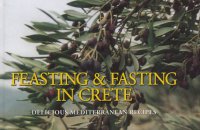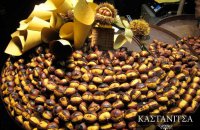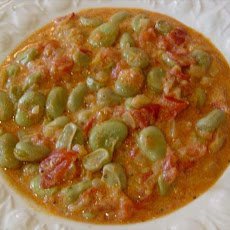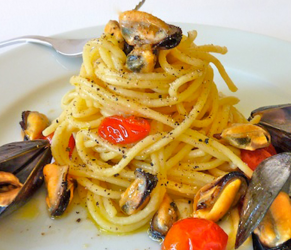Across the Greek countryside, winter is marked by the festive ritual of the "hirosfagia," or pork slaughter. Farmers slaughter their yearly pig in order to crown the Christmas dinner table with it. Then, they smoke the left-overs, air drying the meat, salting it, and turning it into sausages. In preserving the meat in the animal's own fat, villagers can savor pork straight through to Easter.
There are many regional variations regarding pork preparation. While some localities prefer sausages and salamis, others prefer dishes with small pork chops. The recipes are endless.
Roasted and Stewed Pork
Whole roasted suckling pig is the king of the holiday table. It is usually seasoned simply with lemon and oregano, but there are also recipes from the North of the country that call for for suckling pig stuffed with chestnuts, pine nuts, cheese, onions, and spices.
Dozens of stewed pork dishes are found on our winter table as well. Among them are pork stewed with white beans from Macedonia, as well as pork with greens or with leeks and avgolemono. Such a dish is made all over the country, but is most prevalent in the north. A rich dish of pork with walnut sauce is also found in the country's colder parts. In Lesvos, one recipe called "Christougeniatiko" is an unusual combination of pork stewed with chickpeas, chestnuts and tomatoes. In Cyprus, we find "Afelia," or pork cooked with red wine and coriander.
Cured Pork Preparations
Similarly, the cured pork recipes of Greece, including sausages and other charcuterie, seem endless. Still, many have been lost since the dawn of refrigeration, given that villagers need not come up with complicated recipes to allow for the pork's preservation through the winter.
Smoked and dried sausages and salamis have a long tradition in Greece, although they might be considered commonplace and dull for the Christmas festivities of today's day and age. Sometimes they are made with a combination of pork and beef. All around Greece they are seasoned differently, sometimes with leeks, or with leeks and orange rind, other times with pepper, wine, mint and perhaps oregano.
Pork Offal
Greeks also eat a fair share of pork offal, the recipes of which have remained unchanged over millennia. Like the ancient Greeks, today’s Greek cooks still make elaborate stuffed dishes with pork bellies, intestines, and other organ meats. Similarly, there are a number of recipes from the islands that call for pork intestine stuffed with raisins, rice, onions, greens, and herbs. Such a dish, found in the Cyclades and in Crete, goes by the name "maties," "amathies," or "omaties."
"Pihti," jellied pork or head cheese as it is known in English, is another preparation that makes its appearance throughout Greece on the Christmas table, given that the head and hooves of the pig contain an extraordinary amount of gelatin.
While the holiday table is still centered around pork and its many byproducts, urban cooks in today's day-and-age have adopted the turkey as their holiday specialty. Turkey became popular among the upper classes in Greece around the turn of the century. But rich and filling pork seems more apropos of the Christmas feast. It is among the few animals that are delicious all over, literally from head.. to foot.
The Many Forms of Pork
For centuries, fresh pork meat has been enjoyed as a delicacy at Christmas dinner tables accross Greece, but then preserved and savored for the rest of the year.
Country:
Category:
Related Articles
Most Popular recipes


































































